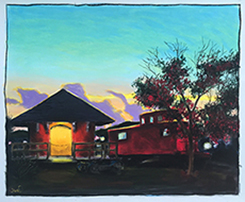JAMES ROMBERGER GOES FOR THE GOLD
“Dust”
Pastels by James Romberger
Dorian Grey Gallery
November 19 – January 3, 2016
James Romberger is the king of pastels, legendary for his gritty urban scenes of the Lower East Side. These new works signal a shift that began a couple of years ago in France, toward views of peace and prosperity while preserving a socially critical eye. In this show, Romberger has traded the city as a primary subject matter and returned to his roots on Long Island’s North Fork.
Homes around the town of Greenport are the focus of several pieces. Among these, the nocturnes will knock your socks off. Architecture, with its connotations of security, is presented as aloof and remote. In “Pink Dusk,” evening is presaged by a ribbon of pink. Situated behind a protective fence, a two-story home is silhouetted. The driveway is lit up triggering competing associations: is this a warm welcome or a security measure?
“Island Nocturne” is keenly handsome. A barn style home is seen from the street. Framing it on either side is the Long Island Sound, its Prussian blue surface matched by a band of equally blue sky. The porch is brightly lit up, as is one second story window. But no humans are visible. Romberger manages to imbue this scene of tranquility and domesticity with sublime intimations. While the picture is unequivocally beautiful, the excessive lighting on the porch and on the horizon is also foreboding, reminding us of global warming and rising sea levels.
The show includes five still lifes, representing another thematic shift for Romberger. It’s fitting that among the yard sale items depicted, is a copy of Mythologies by Roland Barthes, whose theories observe how we see things and what their multiple codes signify. The book is paired with cutesy kitsch figures and a bouquet in a vase, all placed on a folded cloth. The compositional elements harmonize with each other, their various shapes forming a fluid and dynamic tableaux.
“Still Life #2” substitutes the book with an I-phone. An old-fashioned lamp casts a homey spell on the scene. If it weren’t for the I-phone, this inviting picture would be an acronym, evoking a nostalgic flashback to Sinclair Lewis’s bourgeois character Babbitt and his seemingly cozy reading chair. Echoing Barthes’ critiques of archetypes, the objects that Romberger chooses to include invite scrutiny regarding taste, the popular imagination and aspiration.
“Greenport Station” is an unabashedly sentimental masterpiece. The colors have skewed slightly toward Fauvism. Purple and gold clouds appear on the horizon. A red caboose is parked at an angle by the terminal. Here at the end of the line, we’re primed and ready for a magical excursion — and James Romberger provides our conveyance.
